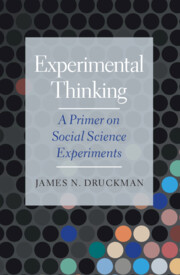Book contents
- Experimental Thinking
- Experimental Thinking
- Copyright page
- Dedication
- Contents
- Figures
- Tables
- Preface
- Acknowledgments
- 1 Why a Primer on Social Science Experiments?
- 2 The Scientific Process and How to Think about Experiments
- 3 Evaluating Experiments
- 4 Innovations in Experimental Designs
- 5 What to Do before, during, and after an Experiment
- 6 Designing “Good” Experiments
- References
- Index
1 - Why a Primer on Social Science Experiments?
Published online by Cambridge University Press: 12 May 2022
- Experimental Thinking
- Experimental Thinking
- Copyright page
- Dedication
- Contents
- Figures
- Tables
- Preface
- Acknowledgments
- 1 Why a Primer on Social Science Experiments?
- 2 The Scientific Process and How to Think about Experiments
- 3 Evaluating Experiments
- 4 Innovations in Experimental Designs
- 5 What to Do before, during, and after an Experiment
- 6 Designing “Good” Experiments
- References
- Index
Summary
Chapter 1 discusses of the evolution of experiments, illustrating this development through the field of political science. The author argues that the discipline currently finds itself in a new era, parts of which apply to all of the social sciences. This new era began around 2010 and reflects the confluence of experiments achieving widespread acceptance in the discipline, technological advances, and the open science movement (these latter two dynamics have affected all of the social sciences). The era introduces many opportunities but also novel challenges. Ironically, the ease of conducting experiments today has the potential to undermine their quality. I conclude the chapter by discussing the motivation for the primer and reviewing the remainder of the book.
- Type
- Chapter
- Information
- Experimental ThinkingA Primer on Social Science Experiments, pp. 1 - 14Publisher: Cambridge University PressPrint publication year: 2022

